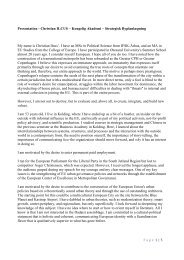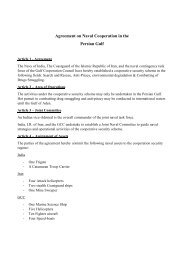china IR rev final sept 2023
This is the fourth and penultimate edition of my annotated bibliography on China international relations, art and Philosophy. from the books I distill policy relevant ideas for use and comsideration of policymakers after the ratification of the Cai, when the relatioship willl have to be managed
This is the fourth and penultimate edition of my annotated bibliography on China international relations, art and Philosophy. from the books I distill policy relevant ideas for use and comsideration of policymakers after the ratification of the Cai, when the relatioship willl have to be managed
Create successful ePaper yourself
Turn your PDF publications into a flip-book with our unique Google optimized e-Paper software.
Benjamin Barton Political trust and the politics of Security Engagement:<br />
China and the European Union in Africa, Routledge, 2017.<br />
In 2008, the EU Commission published a communication on the trilateral cooperation between the EU and China in<br />
Africa. However, this policy has yet to generate headlines or make great strides. EU and China are still to convert<br />
rhetorical promises into tangible cooperation results concerning international security. This book develops a theoretical<br />
framework to explain why the EU and China worked together in the Gulf of Aden but in Darfur. The author contends<br />
that a lack of political trust is at issue. I submit that China and the EU should start cooperating on solving the Great<br />
Lakes conflict, one of three conflicts that have endured since the dawn of the UN, the other being Kashmir and the<br />
Middle East Peace Process (MEPP). Ian Taylor has published a book on China’s rise in Africa, while Anna Katherina<br />
Stahl has published EU-China-Africa Trilateral Relations in a multipolar world. The environmental challenges, the<br />
demographic growth, the market potential, and the endemic conflicts provide sufficient material to warrant a <strong>rev</strong>iew of<br />
the trilateral cooperation between EU-AU-China. One of several unknown departure points could be addressing the<br />
African’s wants, engaging in the Great Lakes region, possibly even Darfur, and smearing the wheels of the various antidesertification<br />
initiatives and the associated need for policies and institution-building.<br />
Hong Zhou China-EU relations: Reassessing the China-EU Comprehensive<br />
Strategic Partnership, Springer, 2018.<br />
This book provides a comprehensive <strong>rev</strong>iew of relations between China and the EU Strategic partnership from the<br />
perspectives of politics, economy, and culture to better understand the development of the EU-China Strategic<br />
Partnership.<br />
Ian Easton The Chinese Invasion Threat: Taiwan’s Defense and American<br />
Strategy in Asia, Eastbridge Books, 2019.<br />
Are war clouds gathering in Asia? Will China make good threats to invade Taiwan? What would this conflict mean for<br />
America and the World? Mao raised these questions in the book in his conversations with Kissinger, which would only<br />
have to be solved fifty years after the opening to the United States. Expo-sing internal Chinese military documents and<br />
restricted-access studies The Chinese Invasion Threat explores the secret world of war planning, strategy, espionage,<br />
and national security. This book provides a background to the elevation of staunch -pro-unification officers to China’s<br />
Military Commission and Pentagon’s China Military Power Report 15 . A particular unit has been established to study<br />
war preparedness and war contingency planning in Taiwan. Thus, both sides should work actively to ensure that<br />
competition with China does not conflict. Xi Jinping has called for the CCP to develop the people’s “war doctrine and<br />
build a strong strategic deterrence system.” This translates into a strategy of winning the masses and adopting a<br />
principle of defensiveness. “ A people’s war is a total war, and its strategy and tactics require the overall mobilization of<br />
political, economic, cultural, diplomatic, military and other power resources, the integrated use of multiple forms of<br />
struggle and combat methods,” the PLA states. Asymmetric warfare and flexibility are called for. I submit that a selfreinforcing<br />
dynamic has been put into place, increasing the risk of war. However, what is suitable for the party is not<br />
necessarily good for the nation. The fact remains: The arrangements between China and the US have served Taiwan and<br />
China well, as both countries have experienced significant growth. And Taiwan’s policy is Congress-led and does not<br />
preclude or reinforce the need for open communication channels. At the same time, China feels the US “disregards<br />
China’s concerns and creates artificial obstacles.” PLA thinks the “US should take practical actions and show sincerity<br />
and correct mistakes, to create the necessary conditions and proper atmosphere for communication and exchange<br />
between the two sides.” This includes the lifting of sanctions, a harbinger of conflict. For a perspective from Chiang<br />
Kai-shek and his role in providing a Chinese model of modernization, consult Jay Taylor’s The Generalissimo – and the<br />
Struggle for Modern China.<br />
15<br />
https://www.defense.gov/News/News-Stories/Article/Article/3230682/<strong>china</strong>-military-power-report-examineschanges-in-beijings-strategy/<br />
Page 10 | 29








